
The Caridea, commonly known as caridean shrimp or true shrimp, from the Greek word καρίς, καρίδος, are an infraorder of shrimp within the order Decapoda. This infraorder contains all species of true shrimp. They are found widely around the world in both fresh and salt water. Many other animals with similar names – such as the mud shrimp of Axiidea and the boxer shrimp of Stenopodidea – are not true shrimp, but many have evolved features similar to true shrimp.

Dendrobranchiata is a suborder of decapods, commonly known as prawns. There are 540 extant species in seven families, and a fossil record extending back to the Devonian. They differ from related animals, such as Caridea and Stenopodidea, by the branching form of the gills and by the fact that they do not brood their eggs, but release them directly into the water. They may reach a length of over 330 millimetres (13 in) and a mass of 450 grams (1.0 lb), and are widely fished and farmed for human consumption.

The Decapoda or decapods are an order of crustaceans within the class Malacostraca, and includes crabs, lobsters, crayfish, shrimp, and prawns. Most decapods are scavengers. The order is estimated to contain nearly 15,000 extant species in around 2,700 genera, with around 3,300 fossil species. Nearly half of these species are crabs, with the shrimp and Anomura including hermit crabs, porcelain crabs, squat lobsters making up the bulk of the remainder. The earliest fossils of the group date to the Devonian.
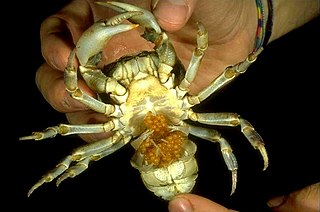
Pleocyemata is a suborder of decapod crustaceans, erected by Martin Burkenroad in 1963. Burkenroad's classification replaced the earlier sub-orders of Natantia and Reptantia with the monophyletic groups Dendrobranchiata (prawns) and Pleocyemata. Pleocyemata contains all the members of the Reptantia, as well as the Stenopodidea, and Caridea, which contains the true shrimp.
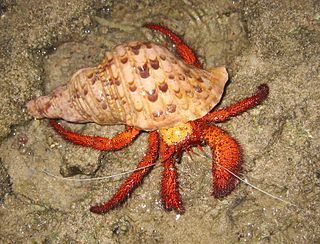
Anomura is a group of decapod crustaceans, including hermit crabs and others. Although the names of many anomurans include the word crab, all true crabs are in the sister group to the Anomura, the Brachyura.

The Stenopodidea or boxer shrimps are a small group of decapod crustaceans. Often confused with Caridea shrimp or Dendrobranchiata prawns, they are neither, belonging to their own group.

Astacidea is an infraorder of decapod crustaceans including lobsters, crayfish, and their close relatives.

Eucarida is a superorder of the Malacostraca, a class of the crustacean subphylum, comprising the decapods, krill, and Angustidontida. They are characterised by having the carapace fused to all thoracic segments, and by the possession of stalked eyes.
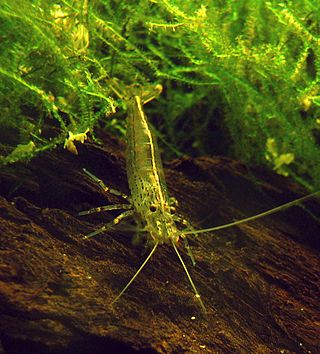
Atyidae is a family of shrimp, present in all tropical and most temperate waters of the world. Adults of this family are almost always confined to fresh water. This is the only family in the superfamily Atyoidea.
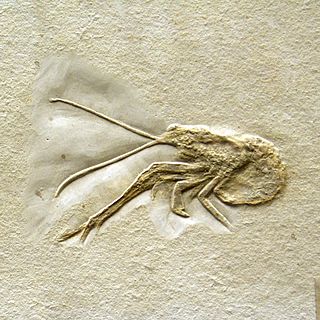
Glypheidea is an infraorder of lobster-like decapod crustaceans, comprising a number of fossil forms and the two extant (living) genera Neoglyphea and Laurentaeglyphea: The infraorder was thought to be extinct until a living species, Neoglyphea inopinata, was discovered in 1975. They are now considered "living fossils", with over 256 fossil species discovered, and just two extant species.

The family Oplophoridae is a taxon of pelagic shrimp and the only subtaxon of the superfamily Oplophoroidea. It contains the following genera:
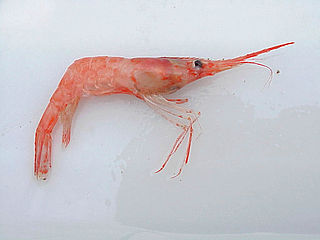
The family Pandalidae is a taxon of caridean shrimp. These species are commonly called pandalid shrimp. They are edible and have high economic value. They are characterised by the subdivided carpus of the second pereiopod and, mainly, by the lack of the chelae (claws) on the first pereiopod. This is a cold-water family, and their representation in tropical areas is made by deep-sea shrimp. The genus Physetocaris, sometimes placed in this family, is now considered to be in its own family, Physetocarididae.
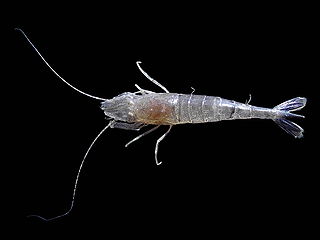
Crangonidae is a family of shrimp, of the superfamily Crangonoidea, including the commercially important species Crangon crangon. Its type genus is Crangon. Crangonid shrimps' first pair of pereiopods have partially chelate claws that they use to capture their prey. They burrow shallowly into sediment on the sea floor, and feed on bivalves, crustaceans, polychaetes, and some small fish.
Physetocaris is a monotypic genus of caridean shrimp, containing a single species, Physetocaris microphthalma.

Polychelida is an infraorder of decapod crustaceans. Fossil representatives are known dating from as far back as the Upper Triassic. A total of 38 extant species, all in the family Polychelidae, and 55 fossil species have been described.
Tetrachela raiblana is an extinct species of polychelid crustacean from the Late Triassic. It is the only species in the family Tetrachelidae. It is distinguished from most other polychelids, including all the extant Polychelidae, by the retention of the diaeresis (divisions) of the uropodal exopods.
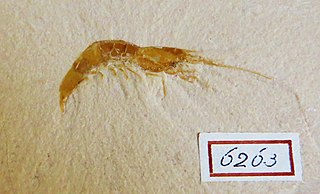
Hefriga is an extinct genus of shrimp in the order Decapoda. It contains three species, and lived in the Jurassic period.

The Processidae are a family of shrimp, comprising 65 species in five genera, and the only family in the superfamily Processoidea. They are small, nocturnal animals, mostly living in shallow seas, particularly on grass flats. The first pereiopods are usually asymmetrical, with a claw on one, but not the other. The rostrum is generally a simple projection from the front of the carapace, with two teeth, one at the tip, and one further back.

Bresilioidea is a superfamily of shrimp. It is likely to be an artificial group, containing five families which may or may not be related.
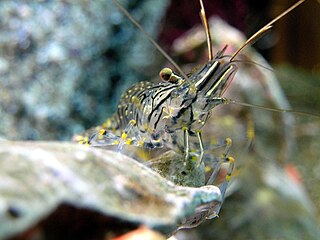
Palaemonoidea is a large superfamily of shrimp, containing nearly 1,000 species. The position of the family Typhlocarididae is unclear, although the monophyly of a group containing the remaining seven families is well supported.


















